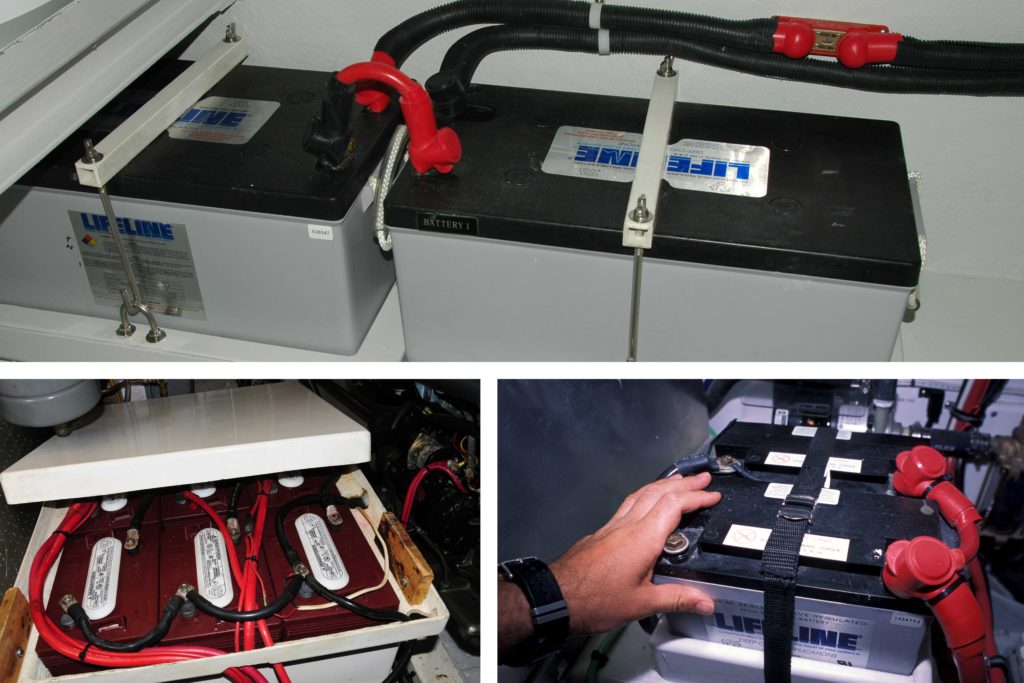
The bow was enveloped by yet another azure wave, and like all the others, it exploded into a plume of snow-white briny mist, stopping our forward motion. We were above the Arctic Circle, far from any sort of assistance, and I thought for the hundredth time: I wonder how the batteries are doing? Are they secure? Are the cables tight? Is anything chafing? These are the sorts of things I think about while on watch.
It’s not often I differ with the well-established guidelines set forth by the American Boat and Yacht Council (ABYC). The matter of battery installation is one of a handful of exceptions. Among other things, the standard regarding battery installations details the amount a battery is allowed to move after it’s been installed: “Batteries, as installed, shall be restrained to not move more than one inch in any direction when a pulling force of twice the battery weight is applied through the center of gravity of the battery as follows: vertically for a duration of one minute, and horizontally and parallel to the boat’s centerline, for a duration of one minute fore and one minute aft, and horizontally and perpendicular to the boat’s centerline for a duration of one minute to starboard and one minute to port.”
In the scheme of things, given this sort of latitude for movement, just about any piece of equipment — particularly items as heavy as a battery — will eventually come to grief. If a battery moves with every wave the vessel encounters — we’re talking hundreds, or thousands, of times in a given passage — the stress imparted to the battery, and the potential for chafe or the loosening of cables and connections, is very real indeed.
Based on my experience in both the boatyard and at sea, my preference is for the complete immobilization of batteries. This can be accomplished with a clamp-type strong back arrangement, or heavy ratcheting straps using stainless-steel buckles. Forget the wimpy nylon strap with a plastic buckle; while fine for a runabout or tender, it is simply inadequate for large batteries in seagoing vessels. Complete immobilization of batteries becomes more challenging when they are installed in boxes, particularly if the box is oversize, as so many are.
Contrary to popular belief, compliance with ABYC Standards does not mandate that batteries be installed in boxes. In fact, unless they are of the flooded variety, I’d argue batteries are better off without boxes; eliminating them offers better ventilation and makes regular inspection far easier and thus far more likely. Once again, the standards state: “Provision shall be made to contain incidental leakage and spillage of electrolyte. Note: Consideration should be given to: 1. the type of battery installed (e.g., liquid electrolyte or immobilized electrolyte); 2. the boat in which the battery is installed (e.g., angles of heel for sailboats, and accelerations for powerboats).” It makes little sense, therefore, to install a gel or AGM battery in a box, since leakage is essentially impossible. Flooded batteries, of course, do benefit from 100 percent containment, since they are prone to leakage and occasionally explode.
Fasteners used to secure battery boxes or trays must not be installed in an area where they might come into contact with spilled electrolyte; i.e., they cannot be inside the box, making a further case for an external clamp or strap arrangement. Additionally, unless these are through-bolts (most of the fasteners used for battery installations I encounter are tapping screws), it’s likely the installation will fail to meet the above-mentioned static load test.
Finally, where batteries are installed in boxes, using the common shoebox-lid design, the apex of the lid must be vented to allow hydrogen gas to escape. This applies to sealed AGM and gel batteries as well; under overcharge conditions, these can vent hydrogen gas. Batteries that are poorly secured are more likely to suffer from loose and arcing connections. Add that to a design whose boxes fail to vent hydrogen, and you have an explosion in the making.
Steve D’Antonio offers services for boat owners and buyers through Steve D’Antonio Marine Consulting (stevedmarineconsulting.com).








